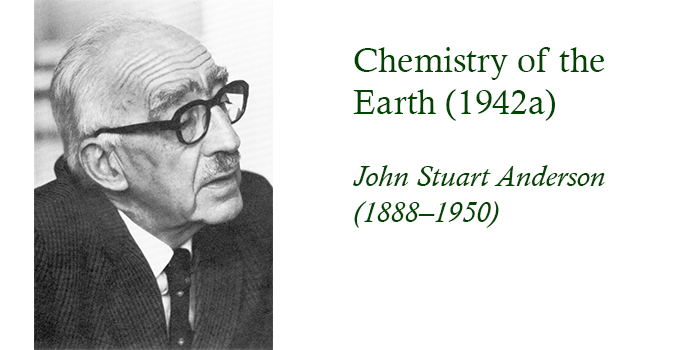4a: Chemistry of the Earth (1942a)
Abstract
Liversidge Research Lecture delivered on October 27th, 1942, at Science House, Sydney, arranged by the Royal Society under the terms of the Liversidge bequest. Reproduced by permission of the Royal Society of New South Wales from J. Proc. Roy. Soc. N.S.W., 1942, 76, 329–344.
"Few developments in science have made so vital a contribution to chemical theory as has the knowledge that has been acquired, since Laue's discovery of the diffraction of X-rays, as to the constitution of the crystalline state of matter. This is especially true of inorganic chemistry, dealing, as it does, with compounds existing for the most part in the solid state as ionic or homopolar aggregates, rather than as molecular units. In this [lecture], therefore, the relation between crystalline structure and chemical theory will be taken as the general underlying theme."
References
Bragg, W.L., 1937. Atomic Structure of Minerals. Cornell Univ. Press, Ithaca.
Brewer, F.M., and Baker, E., 1936. J. Chem. Soc., 1286.
Feit, W., 1930. Z. angew. Chem., 43, 459.
Goldschmidt, V.M., 1922. Z. Elektrochem., 28, 411.
Goldschmidt, V.M., 1935. Ind. Eng. Chem., 27, 1100.
Goldschmidt, V.M., 1937. J. Chem. Soc., 654.
Hevesy, G., 1932. Chemical Analysis by X-rays. McGraw Hill, New York. Pp. 254 et seq.
Jander, W., 1925. Z. anorg. allg. Chem., 143, 377.
Jander, W., and Rothschild, E., 1928. Z. anorg. allg. Chem., 172, 129.
Morgan, G.T., and Davies, G.R., 1937. Chem. and Ind., 15, 717.
Noddack, I., and Noddack, W., 1930. Naturwiss., 18, 757.
Noddack, I., and Noddack, W., 1931a. Z. physikal. Chem., A, 154, 207.
Noddack, I., and Noddack, W., 1931b. Z. physikal. Chem., Bodenstein Festband, 890.
Noddack, 1., 1935. Z. anorg. Chem., 225, 337.
Noddack, I., 1936a. Angew. Chem., 49, 1.
Noddack, I., 1936b. Angew. Chem., 49, 835.
Noddack, I., Noddack, W., and Bohnstedt, J., 1940. Z. anorg. allg. Chem., 244, 252.
Paneth, F., 1925. Naturwiss, 13, 805.
Papish, J., and Holt, D.A. Z. anorg. allg. Chem., 192, 90.
Tammann, G., 1923. Z. anorg. allg. Chem., 131, 96.
Tammann, G., 1924. Z. anorg. allg. Chem., 134, 269.
Washington and Clarke, F.W., 1924. U.S. Geol. Survey, Prof. Paper 127.

